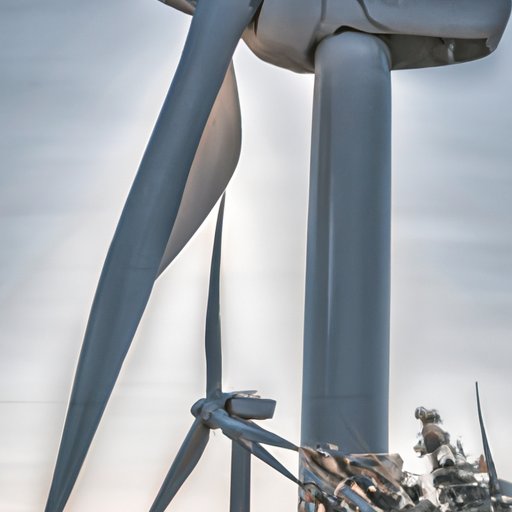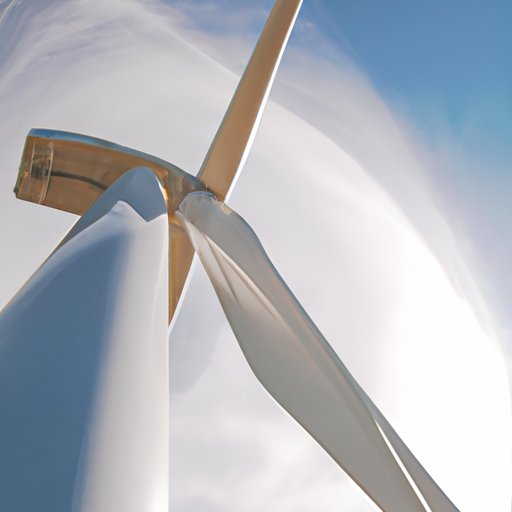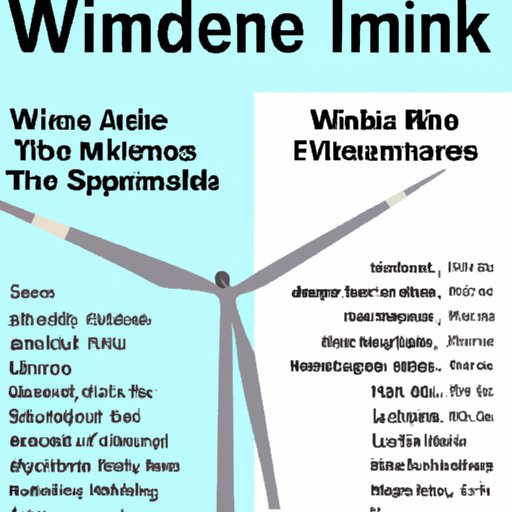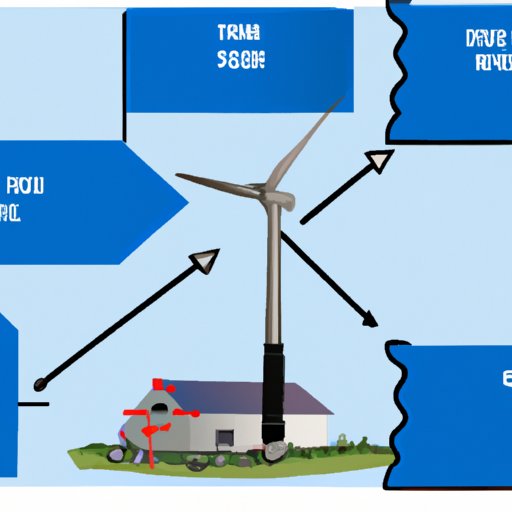Introduction
Wind turbines are becoming an increasingly popular source of renewable energy. As the demand for green energy continues to rise, more and more people are turning to wind power as an alternative to traditional sources of electricity. But with any major investment, it’s important to understand what you’re getting into – and that includes understanding the cost of wind turbines.
What is a Wind Turbine?
A wind turbine is a device that uses kinetic energy from the wind to generate electricity. It consists of three blades attached to a rotor, which is connected to a generator. When the wind blows, the blades spin, causing the rotor to turn and generate electricity. Wind turbines come in a variety of sizes and are used to generate electricity for homes, businesses, and large-scale energy projects.
Overview of the Cost of Wind Turbines
The cost of wind turbines varies depending on a variety of factors, including location, size, type, and government incentives. On average, a small residential wind turbine system costs around $10,000 to $20,000, while a larger commercial system can cost up to $100,000 or more. In addition to the initial cost, wind turbines also require maintenance and operation costs, as well as potential return on investment (ROI).

Analyzing the Cost of Wind Turbines: Breaking Down the Price Tag
When considering the cost of wind turbines, there are several factors to take into account. Let’s take a closer look at each of these factors.
Initial Cost
The initial cost of a wind turbine system depends on the size and type of turbine you choose. Smaller systems are usually less expensive than larger ones, but they may not be able to generate as much electricity. According to research conducted by the National Renewable Energy Laboratory, the cost of a small residential wind turbine system ranges from $10,000 to $20,000. Larger commercial systems can cost up to $100,000 or more.
Maintenance and Operation Costs
In addition to the initial cost, there are also ongoing maintenance and operation costs associated with wind turbines. These include costs for regularly scheduled inspections, parts replacement, and repairs. The amount of money spent on maintenance and operation will depend on the size and type of turbine you choose, as well as the age and condition of the system.
Lifespan and Potential ROI
The lifespan of a wind turbine can vary greatly depending on the make and model, but most last between 15 and 20 years. During this time, the turbine should generate enough energy to pay back its original cost. According to a study conducted by the Lawrence Berkeley National Laboratory, the average return on investment for a small residential wind turbine system is 10 to 25 percent.
How to Budget for a Wind Turbine Installation
Before investing in a wind turbine, it’s important to evaluate your site and determine the size of turbine you need. Here are some tips for budgeting for a wind turbine installation.
Evaluating Your Site for a Wind Turbine
The first step in budgeting for a wind turbine installation is to evaluate your site. You’ll need to consider the local wind speed, terrain, and other environmental factors to determine whether or not the site is suitable for a wind turbine. You may also need to obtain permits or other approvals from your local government before you can install a turbine.
Determining the Size of Wind Turbine Needed
Once you’ve evaluated your site, you’ll need to determine the size of wind turbine you need. The size of the turbine will depend on the amount of energy you want to generate, as well as the local wind speed. Smaller turbines are usually less expensive than larger ones, but they may not be able to generate enough electricity to meet your needs.
Calculating the Total Cost
After evaluating your site and determining the size of turbine you need, you can calculate the total cost of the project. This includes the cost of the turbine, installation, and any necessary permits or approvals. In addition, you should factor in the cost of maintenance and operation over the life of the turbine.
The Pros and Cons of Investing in a Wind Turbine
Investing in a wind turbine can be a great way to reduce your carbon footprint and save money on energy bills. However, there are both benefits and drawbacks to consider before making the decision to invest in a wind turbine.
Benefits of Wind Turbines
The primary benefit of wind turbines is that they generate clean, renewable energy. This means that they don’t produce any emissions or pollution, making them a more environmentally friendly option than traditional sources of energy. In addition, wind turbines can help you save money on your energy bills, and they may even qualify you for certain tax credits and other financial incentives.
Drawbacks of Wind Turbines
One of the drawbacks of wind turbines is that they require a significant upfront investment. They also require regular maintenance and may not generate enough electricity to offset the cost of installation and operation. In addition, wind turbines can be noisy and may not be suitable for all locations.
What Factors Influence the Cost of Wind Turbines?
The cost of wind turbines is affected by a variety of factors, including location, size, type, and government incentives. Let’s take a closer look at each of these factors.
Location
The location of the wind turbine has a major impact on the cost. Wind speed and terrain can affect the efficiency of the turbine, so it’s important to choose a site that has good wind resources. Additionally, some areas may have additional regulations or restrictions that could add to the cost of the project.
Size and Type of Turbine
The size and type of turbine you choose will also affect the cost. Smaller turbines are usually less expensive than larger ones, but they may not be able to generate as much electricity. Additionally, different types of turbines have different price tags, with horizontal axis turbines typically being more expensive than vertical axis turbines.
Government Incentives
Finally, government incentives can also play a role in the cost of wind turbines. Many governments offer incentives such as tax credits, grants, and subsidies to encourage people to invest in renewable energy. These incentives can help offset the cost of installing and operating a wind turbine.

Understanding the Different Types of Wind Turbines and Their Costs
Wind turbines come in a variety of sizes and types, with each type having its own unique cost. Let’s take a look at the different types of wind turbines and their associated costs.
Horizontal Axis Wind Turbines
Horizontal axis wind turbines (HAWTs) are the most common type of wind turbine. They consist of a rotor with three blades attached to a tower. The blades spin in a horizontal plane, generating electricity as they go. HAWTs are usually more expensive than other types of turbines, but they are also more efficient and can generate more electricity.
Vertical Axis Wind Turbines
Vertical axis wind turbines (VAWTs) are less common than HAWTs, but they are often less expensive and easier to maintain. VAWTs consist of a rotor with blades that spin in a vertical plane. They are typically less efficient than HAWTs, but they can still generate a significant amount of electricity.
Hybrid Wind Turbines
Hybrid wind turbines combine features from both HAWTs and VAWTs. They are typically more expensive than either type of turbine, but they can generate more electricity and are more efficient. Hybrid turbines are ideal for sites with high wind speeds and are becoming increasingly popular for residential and commercial applications.

A Comprehensive Guide to the Cost of Wind Turbines
Now that we’ve explored the different types of wind turbines and their associated costs, let’s take a look at some tips for keeping the cost of wind turbines low.
Summarizing the Cost of Wind Turbines
The cost of wind turbines varies depending on a variety of factors, including location, size, type, and government incentives. On average, a small residential wind turbine system costs between $10,000 and $20,000. Larger commercial systems can cost up to $100,000 or more. In addition to the initial cost, wind turbines also require maintenance and operation costs, as well as potential return on investment (ROI).
Tips for Lowering the Cost of Wind Turbines
There are several ways to lower the cost of wind turbines, including choosing a smaller turbine, taking advantage of government incentives, and evaluating your site for optimal wind resources. Additionally, you should factor in the cost of maintenance and operation over the life of the turbine.
Conclusion
Wind turbines are becoming an increasingly popular source of renewable energy. But how much does a wind turbine cost? This article provided a comprehensive guide to the cost of wind turbines, breaking down the price tag and exploring how to budget for a wind turbine installation. With careful planning and consideration of all the factors involved, you can make an informed decision about whether or not investing in a wind turbine is right for you.
(Note: Is this article not meeting your expectations? Do you have knowledge or insights to share? Unlock new opportunities and expand your reach by joining our authors team. Click Registration to join us and share your expertise with our readers.)
